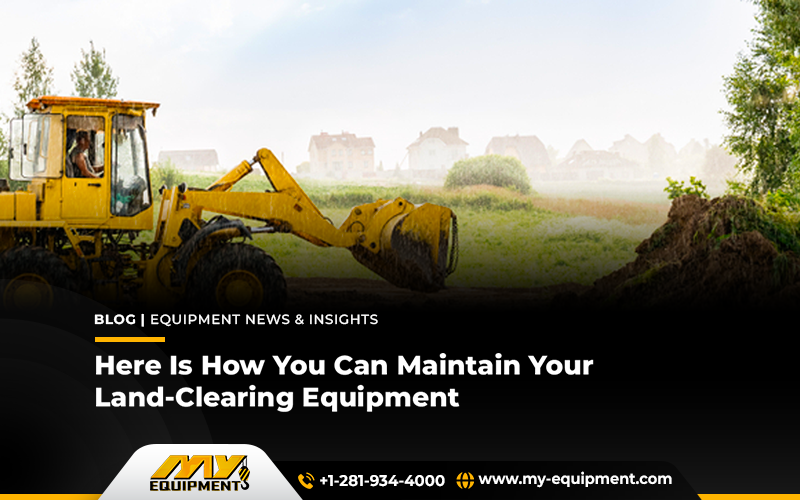Every piece of equipment needs one thing commonly, maintenance and care. Whether you are working with mining equipment, construction equipment or any land-clearing equipment, one thing is certain, maintenance is the key to improving your equipment’s longevity and productivity.
Do you want to know how to smartly keep your land-clearing heavy equipment clean and maintained? Here are some smart tips for your consideration.
The only thing you need to understand is to evaluate which equipment you are using to clear land. After that plan your maintenance schedule and give your equipment all the care it deserves.
Keeping everything clean is the key
When you are clearing the land, it is most obvious that the bushes, debris, plants all will be tangled and come your way. These things will make the equipment dirty and muddy.
Keeping your machine clean is one of the easiest yet most efficient maintenance procedures.
For example, mulching heads may collect debris that jams the rotor, decreasing performance and raising the possibility of damage. Rolling the attachment backwards on the ground can assist in removing the obstruction if the rotor becomes jammed. Make sense now?
Remember that your entire equipment needs the same attention as the attachments. Whether you are using an excavator, wheel loader, skid steer loader or any other specific land-clearing equipment, make sure the entire equipment is being taken care of, not just the attachment.
To avoid excessive wear and tear in your land-clearing equipment like backhoe loader for sale, routinely inspect the hydraulic compartments, blade carrier, and motor housing.
A small amount of cleaning goes a long way toward avoiding performance problems.
Make sure the blades are sharp
Your edge cutters do all the heavy lifting when it comes to clearing land. Reduced efficiency and higher fuel consumption are the results of dull or damaged blades.
Maintaining their sharpness guarantees that your tools will cut through trees and bushes with ease and won’t cause any damage to the equipment overall.
You may need to sharpen your machine’s knives on a regular basis and reverse them if needed. Additionally, pay attention to torque settings; for safe and efficient operation, blade bolts should be properly tightened to about 1,400 ft.-lb.
While overtightening might result in stress fractures, loose bolts can cause misalignment and damage. Hence why, monitoring the condition of the blade will increase performance and prolong the attachment’s life.
Keep this little thing in mind every time you give inspection and maintenance to your equipment.
Be very careful of the rocks and sharp objects
A hidden rock or unexpected debris will slow down your work more than anything else.
These objects may severely harm your mulching head, blade, or perhaps the attachment as a whole. You can avoid expensive repairs by doing a brief job site check before beginning work.
Regularly inspect brush cutters for big material that could become lodged in the blade carrier.
Being stuck in the middle of a task is the last thing you want. Right?
All you need to do is always be active and take necessary proactive measures to simply avoid the risks, while you start working on the job site.
Do not forget your equipment’s hydraulic system
The majority of land-clearing equipment is powered by hydraulics, and costly malfunctions can result from hydraulic system contamination.
Maintaining the condition of your hydraulic hoses, fittings, and oil levels is essential to the efficient operation of your machinery.
Pre-cleaners are a common feature of contemporary machines, including Bobcat models, which keep bigger material out of the engine intake.
This easy-to-use feature can lower the chance of hydraulic contamination and increase filter life. Operators should also replace the oil in oil-filled direct drives every 1,000 hours and grease grease-filled direct drives every 250 hours.
Note that future severe headaches can be avoided by simply following these maintenance schedules.
Pay a close attention to carriers as well
The attachments that your excavator, compact track loader, or skid steer powers are just as important as the machine itself.
To maintain everything in functioning order, daily inspections are essential. Particular attention should be paid to cooling components, air filters, and hydraulic systems, particularly when working in dusty environments.
Maintaining your carrier properly guarantees that it has the strength and dependability to meet the needs of clearing land.
Extra caution while inspecting tyres, tracks, and engine performance will assist avoid unplanned breakdowns if you frequently traverse difficult terrain.
Always prioritize safety over anything
Prioritizing safety is a must when doing maintenance. Turn all equipment off before inspecting or fixing it.
Before operating on hydraulic systems, cutting teeth, or attachments, turn off the power.
Operators and machinery will remain in good condition if they take a few extra minutes to follow safety procedures.


 1400 Broadfield Blvd, Houston, TX 77084,
USA.
1400 Broadfield Blvd, Houston, TX 77084,
USA.